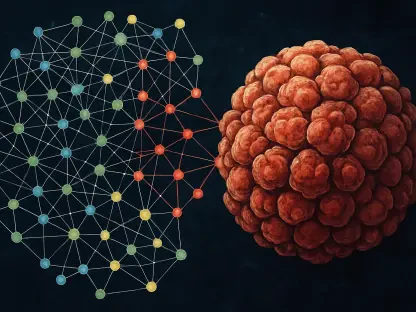In this engaging conversation with biopharma expert Ivan Kairatov, we delve into the complexities and innovations in treating brain metastases from ovarian cancer. Ivan shares insights from a recent study that evaluated the effectiveness of Gamma Knife Stereotactic Radiosurgery (GKSRS) in managing these rare cancer cases. His expertise offers a deep dive into the challenges and promising findings that could influence future treatment approaches.
Can you explain what brain metastases from ovarian cancer (BMFOC) are and why they are generally considered rare?
Brain metastases from ovarian cancer are instances where cancer cells spread from the ovary to the brain. This kind of metastasis is considered rare because ovarian cancer typically spreads to other areas within the abdominal cavity rather than to the brain. The rarity might be due to both biological factors and the blood-brain barrier, which acts as a selective shield that could limit cancer cell migration.
What challenges are typically associated with treating BMFOC given the poor prognosis?
Treating BMFOC is challenging due to its aggressive nature and the complexities of brain involvement. The brain’s sensitivity limits the types of treatments that can be safely used without causing significant collateral damage. Additionally, most patients with BMFOC have a poor overall prognosis, which can limit the aggressiveness of intervention options, necessitating treatments that prioritize quality of life and symptom management.
How does Gamma Knife Stereotactic Radiosurgery (GKSRS) work as a treatment approach for BMFOC?
Gamma Knife Stereotactic Radiosurgery is a non-invasive treatment that uses focused beams of gamma radiation to target and treat brain lesions with high precision. It’s particularly effective for small to medium-sized lesions, allowing for a high dose of radiation to be delivered to the tumor while sparing surrounding healthy tissue. This approach minimizes damage to the surrounding brain structures and is typically done in a single session.
Why might GKSRS be preferred over other treatment modalities for brain metastases?
GKSRS may be preferred due to its precision and reduced risk of damaging healthy tissue. Since it is minimally invasive, patients recover quickly and can often maintain a normal quality of life during and after treatment. It also allows for targeted treatment of multiple lesions in a single session. In comparison, whole-brain radiation therapy, for instance, can have more widespread side effects and may negatively impact cognitive function over time.
You conducted a retrospective analysis for your study. Can you describe the process and objectives of this analysis?
In our retrospective analysis, we reviewed the records of 22 patients treated with GKSRS to evaluate its efficacy and safety in managing BMFOC. The primary objectives were to assess the tumor control rates, potential side effects, and overall outcomes of GKSRS in this specific patient population over a defined period, from January 2015 to May 2019.
What was the age range and median age of the patients involved in your study?
The patients in our study ranged in age from 46 to 72 years, with the median age being 57.7 years. This range provides a diverse view of how various age groups respond to GKSRS, though it’s important to note that individual health and other variables also play crucial roles in treatment effectiveness.
How many brain metastases did each patient have on average, and what was their mean tumor volume?
On average, each patient had between one and nine brain metastases, accounting for a total of 70 treated tumors. The mean tumor volume observed was 3.6 cm³, with a range from 0.1 to 22.7 cm³. These figures are significant in understanding the extent and severity of metastasis each patient was experiencing.
What are the average and range of the peripheral dose used in your study? Why is the peripheral dose significant?
The mean peripheral dose in our study was 16 Gy, with a range from 7 to 20 Gy. The peripheral dose is crucial because it denotes the amount of radiation delivered to the outer boundary of the tumor. This measurement helps ensure that the entire tumor receives a sufficient dose to maximize treatment efficacy without unnecessarily high exposure to the surrounding healthy tissue.
What role does the isodose curve play in GKSRS, and what were the range and average recorded in your study?
The isodose curve represents the distribution of radiation dose around the targeted tumor. In GKSRS, maintaining an appropriate isodose curve is vital for precision targeting, ensuring that radiation exposure is maximized at the tumor site and minimized in adjacent areas. In our study, the mean isodose curve was 54.6%, with a range from 45% to 80%.
What were the observed outcomes at 12 months post-GKSRS in terms of tumor response?
At 12 months after GKSRS treatment, we observed that 47.1% of the metastatic tumors had a complete response, 29.4% exhibited a partial response, 20.6% remained stable, and a small 2.9% showed progression. These outcomes suggest a high level of efficacy for the GKSRS treatment in achieving tumor control within the first year post-treatment.
The study highlighted a 97.1% tumor control rate. What does this rate suggest about the effectiveness of GKSRS?
The 97.1% tumor control rate indicates that GKSRS is highly effective in managing brain metastases from ovarian cancer in the studied cohort. This high rate of tumor control underscores its potential as a valuable treatment option for maintaining tumor stability and reducing progression in a significant majority of patients.
Were there any acute or chronic toxicities observed during the study?
Interestingly, no acute or chronic toxicities were observed in our study. This outcome signifies the potential of GKSRS to provide effective treatment without contributing additional physical challenges or side effects, which is particularly important for patients already managing significant cancer burdens.
Why do you believe GKSRS showed such promising results in this particular cohort of patients?
The promising results likely stem from GKSRS’s precision and its ability to provide intensive treatment directly to metastatic lesions without affecting surrounding tissue. This specificity may lead to effective tumor control with minimal side effects, making it ideal for patients who require targeted interventions and cannot afford to face additional health compromises.
In your conclusions, you mention that treatment should be individualized. What factors should be considered when making treatment decisions for BMFOC patients?
Individualizing treatment involves considering several factors, including the tumor burden, the patient’s overall health and performance status, the extent of extracranial disease, and patient preferences. It’s crucial to balance the potential benefits of aggressive treatment against the possible impact on the patient’s quality of life, especially in light of an already challenging prognosis.
What are the main takeaways from your study regarding the benefits and considerations of using GKSRS for BMFOC?
The key takeaway is that GKSRS offers a high tumor control rate with minimal toxicity, making it a promising treatment for BMFOC. However, it’s vital to tailor treatment plans to individual patient needs and circumstances. The study reinforces the importance of precision medicine and suggests that GKSRS can be a critical component of a comprehensive cancer care strategy.
Do you have any advice for our readers?
Understanding the nuances of treatment options and focusing on quality of life is essential. Open discussions with healthcare providers about preferences and concerns can guide appropriate and personalized treatment decisions, maximizing both efficacy and well-being.









